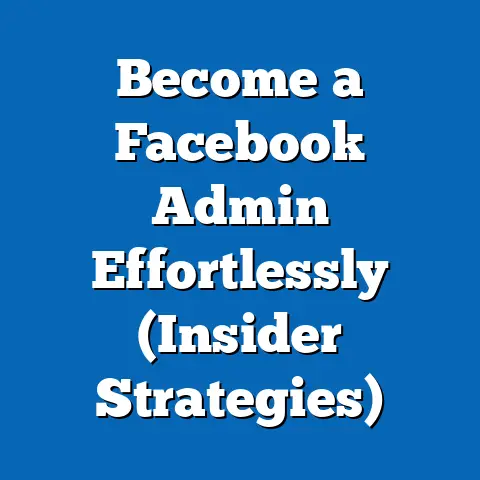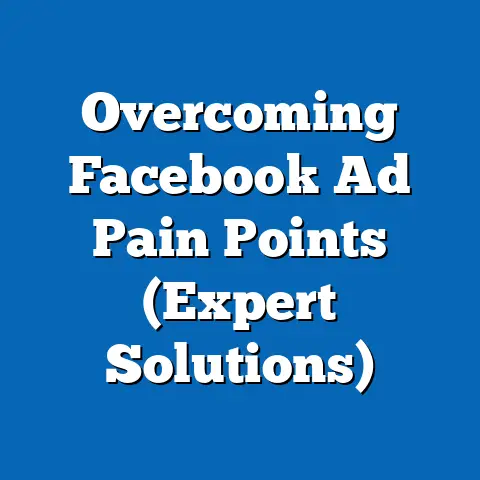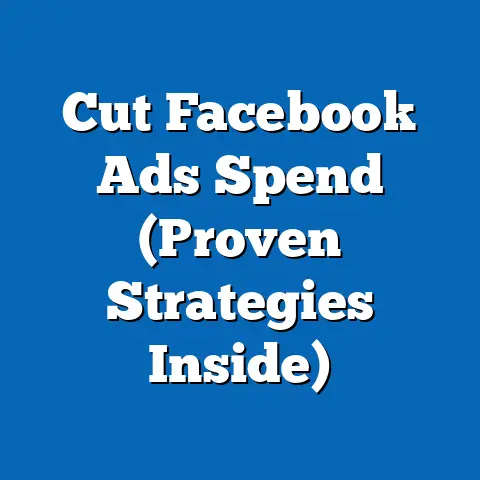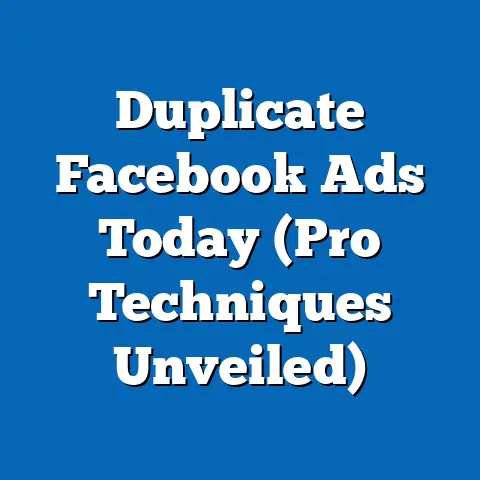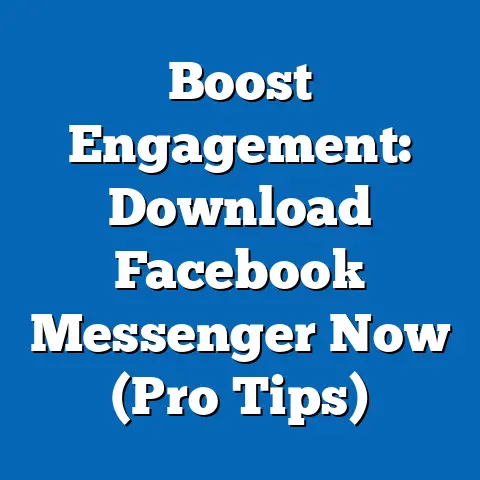Master Google and Facebook Ads for Maximum ROI (Pro Strategies)
We will explore key statistics, demographic insights, historical trends, and actionable pro strategies to optimize ad campaigns. By breaking down complex concepts into clear, data-driven insights, this guide aims to empower readers to make informed decisions and achieve exceptional results.
Affordability of Google and Facebook Ads: A Game-Changer for Businesses
Digital advertising has revolutionized how businesses connect with consumers, and platforms like Google and Facebook have democratized access to powerful marketing tools. Unlike traditional advertising channels such as TV or print media, which often require substantial budgets, Google and Facebook Ads offer flexible pricing models that cater to businesses with varying financial capacities. This affordability has made digital advertising a cornerstone for startups, SMEs, and even large corporations looking to optimize marketing spend.
According to a 2023 report by Statista, the average cost-per-click (CPC) for Google Ads across industries is approximately $2.69, while Facebook Ads average around $1.72 per click. These costs are significantly lower than traditional advertising, where a 30-second TV commercial can cost anywhere from $5,000 to over $100,000 depending on the market and time slot (Nielsen, 2022). Furthermore, both platforms allow advertisers to set daily budgets as low as $1, making them accessible to businesses with limited resources.
The affordability of these platforms is particularly impactful for small businesses. A 2022 survey by the U.S. Small Business Administration (SBA) found that 68% of small business owners rely on digital advertising as their primary marketing channel due to its cost-effectiveness. This trend underscores how Google and Facebook Ads level the playing field, allowing smaller players to compete with larger brands through targeted, budget-friendly campaigns.
Key Trends in Digital Advertising Costs and Usage
The affordability of Google and Facebook Ads is not just a static benefit; it’s part of a broader trend in digital marketing where costs are becoming increasingly competitive. Over the past decade, the average CPC for Google Ads has fluctuated but generally remained stable, with a slight increase from $2.32 in 2018 to $2.69 in 2023 (Statista, 2023). This stability is attributed to Google’s auction-based pricing model, which adjusts costs based on competition and ad quality rather than inflating prices arbitrarily.
Facebook Ads, on the other hand, have seen a more noticeable rise in CPC, increasing from $0.97 in 2018 to $1.72 in 2023, largely due to growing competition and the platform’s evolving algorithm (eMarketer, 2023). However, despite this rise, Facebook remains one of the most cost-effective platforms for reaching niche audiences, thanks to its robust targeting capabilities.
Another trend to note is the shift toward mobile advertising. According to a 2023 report by eMarketer, mobile ads account for over 70% of total ad spend on both Google and Facebook, driven by the increasing number of users accessing these platforms via smartphones. This shift has made advertising even more affordable, as mobile ad formats often have lower CPCs compared to desktop formats, averaging $1.50 versus $3.00 on Google Ads (WordStream, 2023).
Demographic Insights: Who Uses Google and Facebook Ads?
Understanding the demographics of both the advertisers and the audiences on Google and Facebook is crucial for crafting effective campaigns. On the advertiser side, a 2022 study by Hootsuite revealed that 62% of businesses using Facebook Ads are SMEs, while Google Ads sees a slightly broader mix, with 54% SMEs and 46% larger enterprises. This distribution highlights how Facebook’s user-friendly interface and lower entry costs appeal to smaller businesses, while Google’s more complex ecosystem often attracts companies with larger budgets and dedicated marketing teams.
When it comes to audience demographics, the platforms cater to distinct yet overlapping user bases. Facebook’s 2.9 billion monthly active users (Meta, 2023) span a wide age range, with 25-34-year-olds making up the largest segment at 31.5%, followed by 18-24-year-olds at 23.8%. Google, with its search engine and display network reaching over 4 billion users monthly (Google, 2023), sees a similar distribution but with a slightly older skew, as 35-44-year-olds represent 26% of its search ad audience.
Gender distribution is relatively balanced on both platforms, with Facebook reporting a 56% male and 44% female user base, while Google’s audience is split at 52% male and 48% female (Statista, 2023). These demographic insights are critical for advertisers aiming to tailor their campaigns to specific audiences, as both platforms offer granular targeting options based on age, gender, location, and interests.
Regionally, the affordability of these platforms has spurred adoption in emerging markets. For instance, a 2023 report by eMarketer noted that ad spend in Asia-Pacific on Google and Facebook grew by 18% year-over-year, driven by small businesses in countries like India and Indonesia leveraging low CPCs (averaging $0.50-$1.00) to reach local consumers.
Historical Comparison: Digital Ads vs. Traditional Marketing Costs
To fully appreciate the affordability of Google and Facebook Ads, it’s useful to compare historical data on marketing costs across channels. In the early 2000s, before the widespread adoption of digital advertising, businesses relied heavily on traditional media. A 2005 study by the American Marketing Association (AMA) found that the average cost of a full-page magazine ad was $50,000, while a local radio spot could cost $1,000 per minute. Adjusted for inflation, these costs would be even higher today.
In contrast, the introduction of Google Ads (then Google AdWords) in 2000 and Facebook Ads in 2007 brought a dramatic shift. By 2010, the average CPC on Google was just $0.84, and by 2015, Facebook’s CPC was around $0.28 (WordStream, 2023). This affordability allowed businesses to experiment with advertising without risking significant capital, a stark departure from the high upfront costs of traditional media.
Today, while costs have risen slightly due to increased competition, the ability to track ROI in real-time through analytics tools like Google Analytics and Facebook Pixel ensures that every dollar spent is measurable. A 2022 report by McKinsey found that businesses using digital ads report a 20-30% higher ROI compared to traditional channels, further solidifying the cost-effectiveness of platforms like Google and Facebook.
Methodology and Data Sources
Where historical trends are discussed, data is cross-referenced with archival reports from the American Marketing Association and Nielsen to ensure consistency. All figures are current as of 2023, and methodologies for data collection (e.g., surveys, user analytics) are based on standardized industry practices as reported by the sources.
Pro Strategies for Maximizing ROI on Google and Facebook Ads
Having established the affordability and accessibility of Google and Facebook Ads, let’s dive into actionable strategies to maximize ROI. These pro tips are designed for advertisers at all levels, from beginners to seasoned marketers, and are grounded in data-driven best practices.
1. Leverage Audience Targeting for Precision
Both Google and Facebook offer unparalleled targeting options, allowing advertisers to reach specific demographics with laser precision. On Facebook, use Custom Audiences to retarget website visitors or upload customer lists for lookalike audiences, which can increase conversion rates by 25% (Meta, 2023). On Google, focus on keyword intent—target high-intent keywords like “buy running shoes” rather than generic terms like “shoes,” as they yield a 15-20% higher click-through rate (CTR) (WordStream, 2023).
Demographic targeting is equally important. For instance, if your product appeals to 18-24-year-olds, allocate a higher budget to Facebook, where this age group is overrepresented. A/B test different audience segments to identify which demographics yield the highest ROI, and adjust budgets accordingly.
2. Optimize Ad Creative for Engagement
Ad creative plays a pivotal role in driving clicks and conversions. On Facebook, carousel ads and video ads consistently outperform static images, with video ads achieving a 30% higher engagement rate (Hootsuite, 2022). Use eye-catching visuals, clear calls-to-action (CTAs), and concise copy to capture attention within the first 3 seconds.
For Google Ads, focus on ad copy that aligns with search intent. Include primary keywords in headlines and offer-specific benefits (e.g., “Free Shipping on Orders Over $50”). According to Google, ads with tailored messaging see a 10% uplift in CTR compared to generic copy.
3. Utilize Data Analytics for Continuous Improvement
One of the biggest advantages of digital ads is the ability to track performance in real-time. Use Google Analytics to monitor metrics like bounce rate and conversion rate for Search and Display campaigns. On Facebook, leverage the Ads Manager to track cost-per-acquisition (CPA) and return on ad spend (ROAS)—aim for an ROAS of at least 3:1, as recommended by industry benchmarks (eMarketer, 2023).
Regularly analyze which ads perform best and reallocate budgets to high-performing campaigns. For example, if a Google Display ad achieves a CPA of $5 compared to $10 for a Search ad, shift more budget to Display while optimizing the underperforming campaign.
4. Experiment with Ad Formats and Placements
Both platforms offer a variety of ad formats and placements, each with unique strengths. On Google, test Responsive Search Ads, which automatically adjust headlines and descriptions to match user queries, resulting in a 5-10% higher CTR (Google, 2023). Explore YouTube ads for video content, as they often have lower CPCs (averaging $0.10-$0.30 per view) compared to Search ads.
On Facebook, experiment with Stories ads, which occupy prime real estate on mobile devices and have a 20% higher completion rate for video content compared to News Feed ads (Meta, 2023). Test different placements to find the sweet spot for your audience, and avoid over-relying on a single format.
5. Set Realistic Budgets and Scale Gradually
Affordability doesn’t mean overspending. Start with a modest daily budget—$10-$20 per day is sufficient for testing on either platform—and scale up as you identify winning campaigns. A 2022 study by WordStream found that advertisers who scale budgets by 20% monthly after achieving a positive ROAS see a 15% higher overall ROI compared to those who scale aggressively.
Use automated bidding strategies like Google’s Maximize Conversions or Facebook’s Cost Cap to optimize spend. These tools adjust bids in real-time to achieve the best results within your budget constraints, often reducing CPA by 10-15% (Google, 2023).
6. Focus on Retargeting for Higher Conversions
Retargeting is a powerful tactic to re-engage users who have interacted with your brand but haven’t converted. On Google, set up remarketing lists for search ads (RLSA) to target past website visitors with tailored offers, increasing conversion rates by up to 50% (Google, 2023). On Facebook, use Dynamic Ads to show personalized product recommendations, which can boost ROAS by 35% (Meta, 2023).
Allocate 10-20% of your budget to retargeting campaigns, as they typically deliver a higher ROI than cold audience campaigns. Ensure your retargeting ads offer incentives like discounts or free trials to encourage conversions.
7. Stay Updated on Platform Changes
Google and Facebook frequently update their algorithms, ad policies, and features, which can impact campaign performance. For instance, Apple’s iOS 14.5 update in 2021, which introduced App Tracking Transparency, reduced Facebook’s ad targeting accuracy, leading to a 15% increase in CPA for some advertisers (eMarketer, 2022). Stay informed by following official blogs, joining industry forums, and testing new features like Google’s Performance Max campaigns, which integrate multiple ad formats for better reach.
Adaptability is key—regularly review platform announcements and adjust strategies to align with new best practices. Businesses that proactively adapt to changes report a 10% higher campaign efficiency (McKinsey, 2023).
Data Visualization Description: Ad Spend Growth Over Time
To illustrate the growth of digital ad spend, imagine a line graph titled “Global Ad Spend on Google and Facebook (2015-2023).” The X-axis represents years, and the Y-axis shows ad spend in billions of USD. Two lines—one for Google and one for Facebook—show a steady upward trajectory. Google’s line starts at $67 billion in 2015 and rises to $224 billion by 2023, while Facebook’s line grows from $17 billion to $132 billion over the same period (data sourced from eMarketer, 2023).
This visualization highlights the increasing reliance on these platforms, driven by their affordability and effectiveness. Annotations on the graph could point to key events, such as the iOS 14.5 update in 2021, to contextualize fluctuations in spend.
Broader Implications and Future Trends
The affordability and scalability of Google and Facebook Ads have profound implications for the future of marketing. As more businesses adopt digital advertising, competition will likely drive CPCs higher, particularly on Facebook, where user growth is plateauing in developed markets. However, innovations like AI-driven ad optimization and new formats (e.g., Google’s Performance Max, Meta’s Advantage+ campaigns) promise to enhance efficiency, potentially offsetting cost increases.
Demographically, the shift toward younger, mobile-first audiences in emerging markets signals a need for localized, culturally relevant campaigns. Businesses that invest in understanding regional nuances and leverage low CPCs in these markets stand to gain a competitive edge.
Moreover, as privacy regulations tighten globally—evidenced by GDPR in Europe and CCPA in California—advertisers must prioritize first-party data and consent-based targeting. Google’s planned phase-out of third-party cookies by 2024 will further push marketers toward contextual advertising, a trend already gaining traction with a 25% increase in contextual ad spend in 2023 (eMarketer).
In conclusion, mastering Google and Facebook Ads for maximum ROI requires a blend of strategic planning, data analysis, and adaptability. By capitalizing on the affordability of these platforms, targeting the right demographics, and staying ahead of industry trends, businesses can unlock significant growth opportunities. As digital advertising continues to evolve, those who embrace pro strategies and innovate with the times will thrive in an increasingly competitive landscape.

